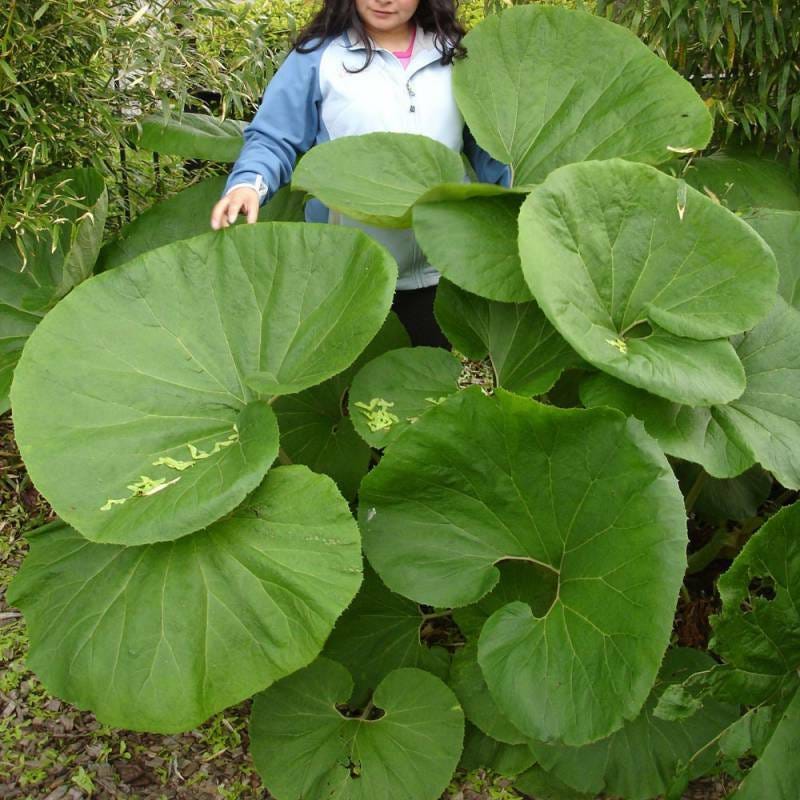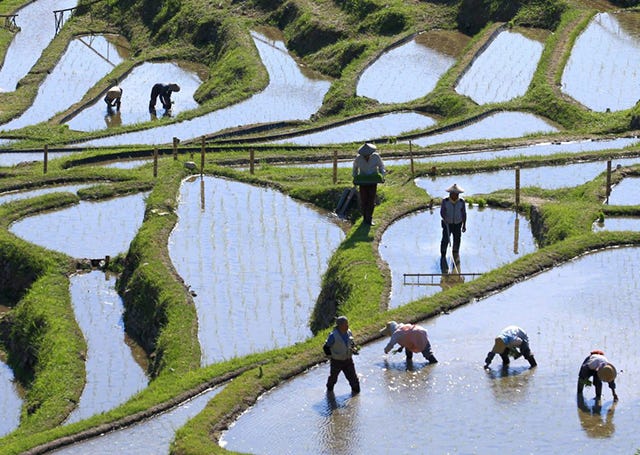Bitter medicine. There’s a category of food in Japan simply known as sansai. This is a catch-all word that loosely means plucked or dug-up sprigs and sprouts from the woods. The nascent beginnings of sunshine-shy ferns and stuff.
Japanese will tempura them, boil them, pickle them, grind them, throw them into hot soba dishes. Most everyone says he loves sansai though the taste is Really Bitter…like you are eating…well, the forest floor.
The spring television shows remind us, lest we forget, that we deeply love sansai. “Ooooo, fabulous,” stars coo as they munch into small green pods and sacs. They smile broadly with scrunched-face expressions registering the bitter blast. Childhood! Hometown! Mama’s cooking! The approved associations pour forth.
I can’t help but think sansai is actually food for starving people. Hey, I admit it—if I knew I was going to die and there was a twig, I’d chew that thing. I’d swallow, and yes I’d have another.
What I wouldn’t do is start imagining that twig as tempura.
All across our valleys a sansai called fuki grows wild. I had to look it up in English—it seems we call this butterbur. Chances are if you’re a gardener you’ve heard of it. A cook not so much. Fuki looks like a whimsical flat round leaf that toads would rest upon in a light drizzle.
The other day Toru and I were walking the dog. Toru began collecting fuki sprouts. Turns out, our walk coincided with the roughly two-week slice of the year when fuki sprouts peek above the soil and are at their most “delicious.” If you wait just a week further, the sprouts get tall and awful to eat. So they say.
We collected a bag of what would look to any non-Japanese person to be fuzzy burr-covered grenades.
Toru hates fuki, but for me he battered them and made tempura. It was excellent, but three of those grassy-tasting bombs were my limit.
JA issues new orders. Japan has been grappling with a national shortage of rice this past year. Price for the grain has more than doubled. As with most any negative turn of events, Japanese try to tie China to the occurrence. “Someone…maybe Chinese…is buying all the rice and holding it off market to make a profit,” you will hear people say.
Those sneaky Chinese!
The real reason is likely more prosaic. For well over a decade, the national agricultural cooperative JA has been telling farmers to get off rice (there’s too much, gentlemen, and if you haven’t noticed we are rapidly disappearing as a population, blah, blah, blah). In Frog’s Glen too you can see the result of JA’s dictates—hundreds of paddies remain fallow while farmers try odd-ball things like gourmet dwarf cabbages, papaya trees, designer onions, and avocados.
Anyway, this year JA flipped the script. With 30 million foreign visitors piling in and all ordering sushi and beef bowl donburi by the shipload, the new message is “Grow rice, slackers!” Just around our house I’d say I am seeing 50% more tambo paddies being flooded for springtime prep. I’m happy. That means more frogs, more predator cranes, and a much more verdant valley to stroll.
Hidenori Hirose is a 60-something farmer that lives up the road from us. I think he’s on his own but I have to admit that until yesterday I hadn’t exchanged a word with him. He always struck me as a laser focused loner working his fields.
Yesterday the whippet Terashima-kun and I headed out for our evening walk. Hirose-san was again at work alone in his patch. I wasn’t sure if I’d get a scowl or a smile but I thought I’d finally call out to him. “It’s just beautiful, really is,” I shouted while nodding toward his field. He uses no machinery, no tractors. He had hand turned, raked, cultivated…almost fluffed(?) a half-acre loamy patch and had dug in pooling walls around the edges.
He smiled broadly. “Thanks!” he called back, as he paused and seemed to briefly admire his own work. “Are you doing rice this year? Will this be a paddy?” I asked. “Yup! It’s been a while but prices are great and I thought why not,” he said.
Hirose-san put down his rake and walked out toward the tiny road where Tera I stood. Like everyone here he seemed to be interested in the odd-looking whippet. “I like your dog. I’ve noticed how quiet and polite he is. Not like the mongrels at other people’s houses here,” he laughed.
Hirose-san is engaging. He told me that seven plots right near our place have been in his family since “at least 1902.” For the past five years he hadn’t farmed any of it. “As I’ve got plenty of energy and really don’t have other things to do, I’ve brought these three patches back on line and will make a go of it again,” he said. He has done tomatoes, melons, cabbage, peas, and onions sporadically. “I enjoy rice most,” he said. “Glad to reflood these and get back to doing what my grandparents were so great at.”
Pineapple shake, anyone? Starting in the late 1960s and continuing well through the 1970s, Japan had an unhealthy obsession with Hawaii. The Japanese call it the “Hawaii Boom.”
Hawaii almost became another word for vacation, for recreation itself.
Hawaii-themed restaurants, resorts, museums, and gift shops opened trying to cash in on domestic travel that grew as Japanese families newly found themselves with spending money. Hawaii cropped up in imaginable tropical climes like Okinawa and Kyushu, but also in wildly inappropriate places like the northern reaches of Hokkaido.
Pop stars sang Hawaiian songs. Bartenders learned Blue Hawaiis. And Hula dance classes became the rage. To this day, you will still find tiki torches and palm trees in inexplicable places like post office parking lots, hospitals, Japanese gardens, and on residential streets.
Near Frog’s Glen on a prime spot overlooking Sagami Bay lies Aloha Gardens, a product of that same Hawaii Boom. Aloha likely had a very good first decade or two, but by the 80s it was on an irreversible downward slide as Japanese increasingly took their vacation savings abroad to Paris, New York, Rome, and well uh the real Hawaii.
With changing national tastes and values, Aloha Gardens went bankrupt in 2006 and was bought out by domestic private equity. (Yes, Japan too has its own barbarians scratching at the gate.) That fund proceeded by its own admission to “do nothing” with the property, and by 2015 the Gardens went belly up a second time. A second new owner stepped in, did even less to revitalize the spot, and now we are told Aloha Gardens will close permanently.
So what was our Aloha Gardens like? It was most known for a domed botanical space—not a terrible idea but Japanese owners couldn’t hold themselves back from faking things up with pineapple shakes, piped in ukulele music, and Waikiki Beach snow globes. To be honest, none of this schlock is a deal breaker to the Japanese tourist but when you’re able to board a plane for some real Aloha five hours away for $400 roundtrip, who’s going to Aloha Gardens?
The Gardens also had a petting zoo, a child’s play area, and a performance space most known for having featured actor and singer Yuzo Kayama on a three night’s stint in 1972. His closing song for each set? “Blue Hawaii.”
Escapism is hard when you really do want to escape. Readers will have noted a slowdown in my writing here from the Glen. One deeply unexciting reason has been the intrusion of work.
I’m referring here to the work that keeps the lights on. I needed to satisfy the corporate Overlords who have become newly excited about…Japan.
Dang, inattention never lasts.
Another reason, if I’m being introspective and honest with myself, has been a post U.S. election malaise. An unmistakable “oh who cares anyway” response to the realization a growing chunk of my home country are ill-intentioned people. Who can write whimsical “life is funny and beautiful” essays in the face of that noise?
I know. Frog’s Glen is about escaping those thoughts and reminding ourselves there is much more to the planet. I’ll work hard to keep that in mind as I push ahead.
My apologies for the pause. I am very glad to be with all of you again.












NO need for an apology...at all. So glad you are back. Loved all the stories!
Frog’s Glen is my non-plane travel. I love every bit of it. I feel my insides sighing, relaxing.
Please don’t apologise. Just share a past story now and then, we will love it.
Rice shortage? The farmers in Guyana were complaining there was a glut, they’d planted so much rice, and prices had dropped. So they say.